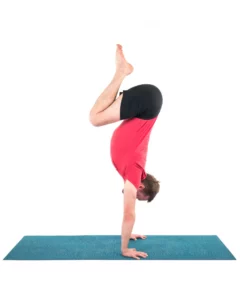The Vagus Nerve and Total Hip Replacement: How to Destress and Heal

Why would I mention the vagus nerve and total hip replacement in the same sentence? Because the vagus nerve is key to helping us heal and to deal with pain and stress.
What is the Vagus Nerve?
 The vagus nerve controls bodily functions like mood, immune response, digestion, and heart rate. It also connects our brain to our digestive tract and sends information about the state of organs to the brain. It communicates our “gut feelings.”
The vagus nerve controls bodily functions like mood, immune response, digestion, and heart rate. It also connects our brain to our digestive tract and sends information about the state of organs to the brain. It communicates our “gut feelings.”
The vagus (vagal) nerve is also known as the 10th cranial nerve or cranial nerve X. It helps to regulate the parasympathetic nervous system (the aspect of our autonomic nervous system related to resting, digesting, feeding, breeding, and healing). It starts in a part of the brain that connects to the spinal cord (medulla oblongata), and at the neck, it divides and runs down through your chest, around your heart, around your lungs, and through your abdomen and intestines.
6 Tips for Stimulating Your Vagus Nerve
Negotiating the challenges of total hip replacement can be stressful. We are often dealing with pain, or worries about the procedure and its outcome. We need tools for managing these stressors. Practicing yoga, especially breathing and restorative yoga, stimulates the vagus nerve and guides us toward healing.
-
Pause to Take a Breath

When stressed, people tend to hold their breath or breathe shallowly. This kind of breathing stimulates the sympathetic nervous system (the part of the autonomic nervous system related to fight or flight). A way to counter this sympathetic response is to activate the vagus nerve through slow, deep belly breathing. By focusing on your breath, you shift focus away from stressful mind chatter and toward the rhythm of the breath.
When you are feeling stressed or worried, try breathing in through your nose for a count of six and out through your nose for a count of eight. Watch your belly expand and contract. This focused breathing will stimulate your vagus nerve and activate your parasympathetic nervous system to help you relax.
-
Practice a Restorative Pose

A restful yoga practice brings the mind to a state of meditation, which activates the vagus nerve and the parasympathetic response. If you have the time and space, practice Reclined Bound Angle Pose (Supta Baddha Konasana). If you are short on time and space, sit in a chair and bend forward into Child’s Pose (Balasana). Not only is this a restful pose, but the pressure on your belly will also stimulate your vagus nerve.
-
Get Some Stimulating Exercise
Exercise has many benefits for the mind and body, including stimulating the vagus nerve. Take a brisk walk, ride your bike, swim, or practice an invigorating yoga sequence.

-
Cool Off
Cold temperatures help stimulate the vagus nerve and reduce the body’s natural stress response. Research shows that taking a cold shower or washing your face in cold water can help slow your heart rate and stimulate blood flow to your brain. Try ending your regular shower with a cold-water rinse, or wash your face in cold water when feeling keyed up.
-
Get a Massage

Massages with gentle pressure on the neck, shoulders, and feet help stimulate the vagus nerve. You can rub your own neck or feet. I like to roll my feet on a tennis ball or get a pal to rub your shoulders for a few minutes.
-
Do Something That Makes You Happy
Engaging with nature or hanging out with people we like stimulates the vagus nerve. So try to get out into nature, smell the flowers, listen to music you like, meet with a friend, appreciate the view from your window, or watch a show that makes you laugh.
It can be hard to get motivated to do good things for our bodies and minds when going through a stressful event like a total hip replacement. Here are several suggestions. Remember, you do not have to do it all at once. Pick one doable thing and enjoy!
Also, read...
In Celebration of Gray-Haired Yoga – Busting the Myth of the Yoga Body
Dec 12 – Charlotte Bell
Stand Firm: 6 Easy Balancing Moves for Your Daily Yoga Routine
Dec 06 – By: Olga Kabel
Related courses
Reprinted with permission from yogaforhipreplacement.com

Elizabeth Freeman (500 E-RYT, YACEP), founder of Yoga for Hip Replacement, has practiced yoga since 1985 and has been a yoga teacher since 1997. She specializes in yoga for people with movement challenges. Her students include those with a range of chronic issues, including Parkinson’s disease, multiple sclerosis, arthritis, and irritable bowel syndrome, as well as those recovering from hip, knee, and shoulder surgeries.
Motivated by her own experience with two hip replacements, she founded Yoga for Hip Replacement as a resource for people preparing for and recovering from hip surgery. She aims to offer safe and accessible yoga practices that support the best hip outcome.
Recent articles
In Celebration of Gray-Haired Yoga – Busting the Myth of the Yoga Body
Dec 12 – Charlotte Bell
4 Yoga Poses to Help Ease High Blood Pressure
Dec 08 – Stanley Clark
Categories
Upcoming courses
Reconnecting with Strength: Your Path to Building Greater Inner Resilience
With Arielle Schwartz
Recent articles
Almost there...
Sorry, we couldn't find anything...
Yoga Practice Tips
In Celebration of Gray-Haired Yoga – Busting the Myth of the Yoga Body
I found my first grey hair when I was 22. It wasn’t completely shocking.…
Dec 12 – Charlotte Bell
Yoga Practice Tips
Judith Hanson Lasater on The Art of Teaching Yoga: Making Every Movement an Asana
Judith Hanson Lasater is one of the longest-teaching yoga teachers in the U.S. In…
Dec 09 – By:
Blood Pressure
4 Yoga Poses to Help Ease High Blood Pressure
Approximately 46 percent of Americans have high blood pressure, based on the American Heart…
Dec 08 – Stanley Clark



